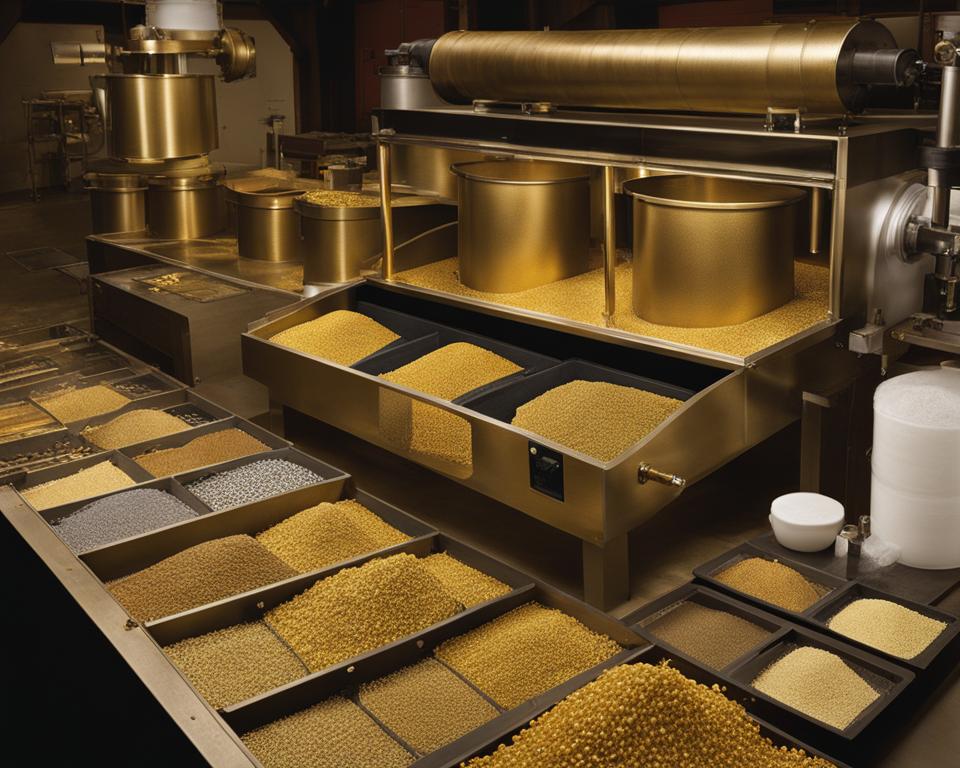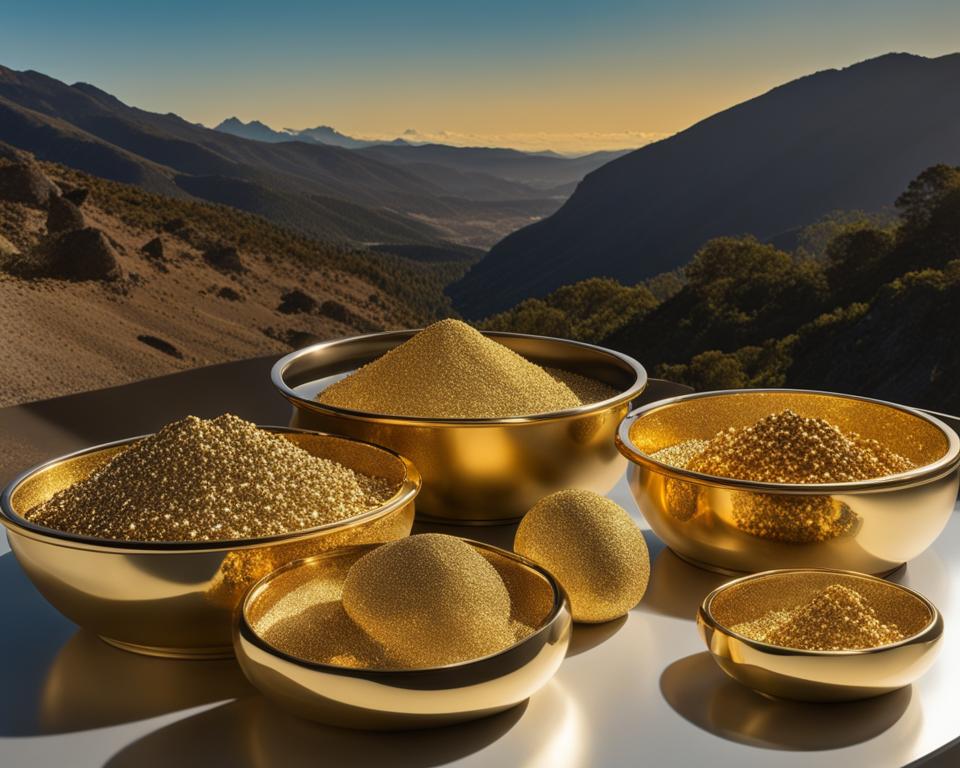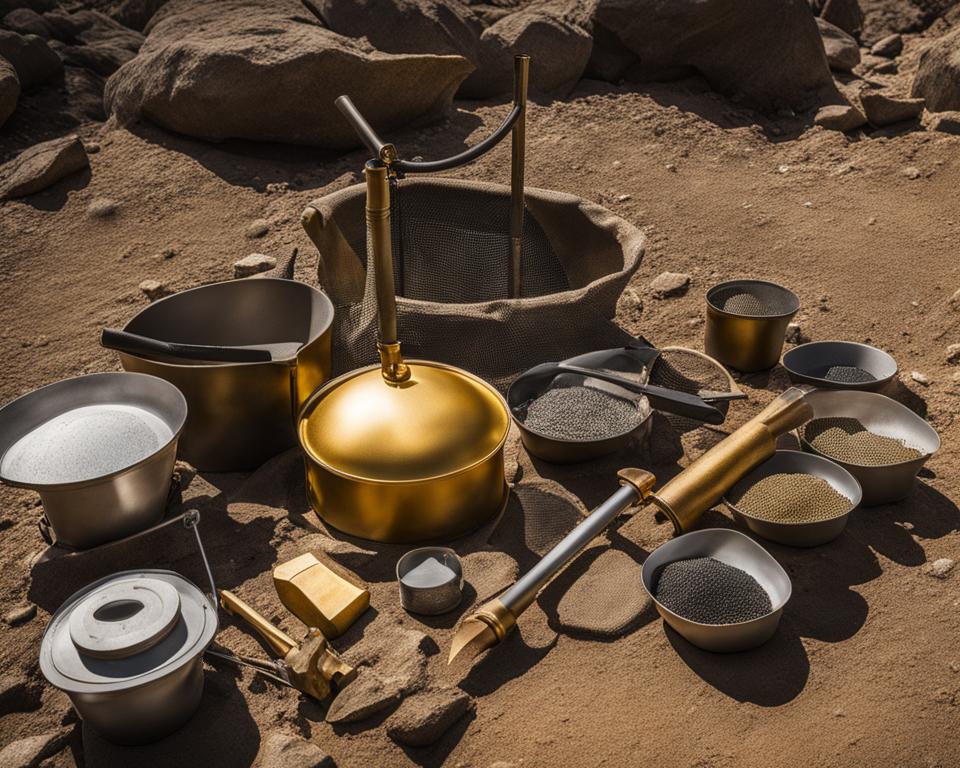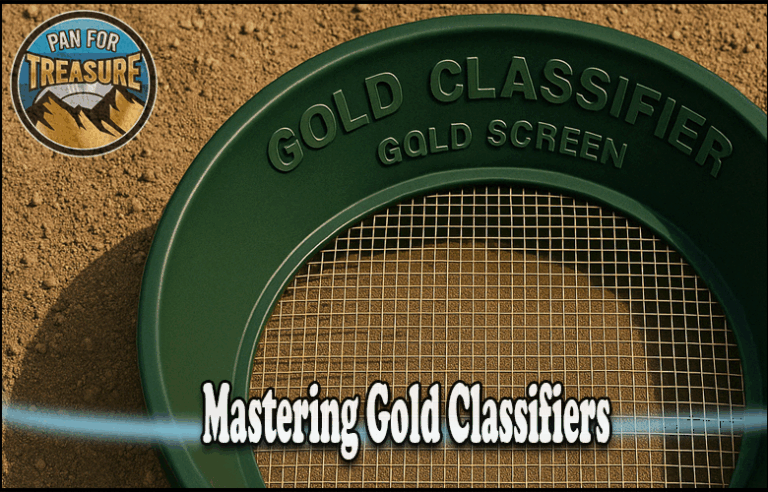Disclosure: This Post Contains Affiliate Links; We earn a commission on purchases.
When it comes to gold prospecting, choosing the right gold classifier is essential for efficient sorting and sifting. The classifier helps to separate larger worthless gravel and rocks, allowing you to focus on the gold-bearing material. It is a must-have tool for improving your gold recovery rates and maximizing your success in the field.
Key Takeaways:
- Choosing the right gold classifier is crucial for efficient gold prospecting.
- The classifier separates larger worthless material, allowing you to focus on the gold-bearing material.
- Proper gold classification improves your gold recovery rates and increases your chances of finding gold.
The Importance of Choosing the Right Gold Classifier
When it comes to gold prospecting, having the right equipment is essential for success. One crucial piece of equipment that often gets overlooked is the gold classifier. Choosing the right gold classifier can make a significant impact on your prospecting endeavors, improving your efficiency and increasing your chances of finding gold.
With the proper gold classifier, you can effectively screen and classify your material, allowing for better fine gold recovery. By separating larger rocks and gravel, the classifier ensures that you are working with the right-sized material that is more likely to contain gold. It eliminates unnecessary processing of worthless material, saving you time and effort.
Using the appropriate gold classifier can greatly enhance your gold panning experience. It allows you to focus your efforts on the material with the highest potential for gold, increasing your productivity in the field. By effectively classifying your material, you streamline the process and improve your chances of finding valuable gold deposits.
“Choosing the right gold classifier is like having a trusted partner in gold prospecting. It helps you separate the gold from the waste, guiding you toward success and maximizing your potential.”
To further illustrate the importance of choosing the right gold classifier, let’s take a look at a comparison table showcasing different types of gold classifiers and their features:
| Gold Classifier | Key Features | Compatibility |
|---|---|---|
| Stainless Steel Mesh Classifier | Durable and rust-resistant | Compatible with various gold pans |
| Plastic Mesh Classifier | Lightweight and portable | Compatible with most gold pans |
| Classifier Sieve | Multiple mesh sizes for precision classification | Requires a classifier stand or bucket |
Choosing the right gold classifier involves considering factors such as the material’s size, durability, and compatibility with your existing gold panning tools. Reading customer reviews and seeking recommendations can help you make an informed decision.
Remember, the right gold classifier is a valuable tool that can significantly impact your ability to find gold. It is an investment in your success as a gold prospector, helping you efficiently separate the valuable material from the waste. So, choose wisely and equip yourself with the right gold classifier for your prospecting adventures.
Types of Gold Classifiers
When it comes to gold prospecting, having the right tools is essential for success. Gold classifiers are indispensable for efficient sorting and sifting, ensuring that you can focus on extracting the valuable gold from your material. In this section, we will explore the different types of gold classifiers available on the market.
Commonly used gold classifiers include:
- Stainless Steel Mesh Panning Sifters
- Plastic Mesh Panning Sifters
- Sieves and Classifiers
These classifiers are designed with varying mesh sizes, ranging from 1/2 inch to fine 200 mesh screens. The mesh size determines the size of the material that will pass through, allowing you to separate larger worthless gravel and rocks from the smaller particles that may contain gold.
| Classifier | Advantages | Disadvantages |
|---|---|---|
| Stainless Steel Mesh Panning Sifters | Durable and long-lasting | Slightly heavier |
| Plastic Mesh Panning Sifters | Lightweight and easy to clean | May not be as durable as stainless steel |
| Sieves and Classifiers | Offer a wide range of mesh sizes | May require additional equipment for effective use |
Selecting the Best Gold Classifier
When choosing a gold classifier, consider the following:
- Your gold pan style: Ensure that the classifier is compatible with your gold pan or other gold prospecting equipment.
- Expected material size: Select a classifier that can handle the size of material you anticipate recovering gold from.
“The right classifier can make all the difference in your gold prospecting journey. Choose wisely and reap the rewards!”
In the next section, we will delve deeper into the factors to consider when choosing a gold classifier, including mesh/screen size and user reviews.
Factors to Consider When Choosing a Gold Classifier
When it comes to selecting the right gold classifier for your gold prospecting needs, there are a few key factors to keep in mind. By considering these factors, you can make an informed decision that will greatly enhance your gold panning experience. Here are the important factors to consider:
1. Size of the Classifier
The size of the classifier refers to its overall dimensions and capacity. It is essential to choose a classifier that fits comfortably within your gold panning setup and is easy to handle. Consider the size of your gold pan and the space available in your prospecting kit to ensure a proper fit.
2. Mesh/Screen Size
The mesh or screen size of the classifier determines the size of the particles it can effectively sort and sift. Different mesh sizes are available, ranging from larger screens that remove larger rocks and debris to finer screens that capture smaller gold particles. Consider the size of gold you are targeting and choose a classifier with an appropriate mesh size.
3. Compatibility with Other Gold Panning Tools
It is important to ensure that your gold classifier is compatible with your other gold panning tools. This includes your gold pan, shovel, and other equipment. Consider the design, shape, and size of the classifier to ensure smooth integration with your existing tools.
4. Gold Classifier Reviews
Reading gold classifier reviews is an invaluable step in the decision-making process. By exploring the experiences and feedback of other gold prospectors, you can gain insights into the effectiveness, durability, and overall performance of different classifiers. Look for classifiers with positive reviews and consider the experiences of others when making your selection.

By carefully considering these factors, you can choose the right gold classifier that meets your specific requirements. Investing in a high-quality and suitable classifier will greatly improve your gold recovery rates and bring you closer to striking gold.
The Best Gold Classifiers for Efficient Gold Prospecting
When it comes to efficient gold prospecting, having the right tools is essential. Gold classifiers play a crucial role in the process by helping you separate the valuable gold from larger worthless gravel and rocks. In this section, we will explore some of the best gold classifiers available on the market, based on positive reviews and their effectiveness in various gold panning techniques.
Here are three top-rated gold classifiers:
- Garrett Super Sluice Gold Pan: This gold pan is renowned for its durability and efficiency. Its deep riffles and wide base allow for effective material classification, enabling you to capture even the finest gold particles. The Garrett Super Sluice Gold Pan is a popular choice among both beginners and experienced gold prospectors.
- Proline Blue 14-Inch Gold Pan: With its rugged construction and well-designed riffles, the Proline Blue 14-Inch Gold Pan excels at classifying material and retaining fine gold. Its larger size makes it suitable for processing larger quantities of material, increasing your productivity in the field.
- Fiskars #2 Spade Shovel: Although not specifically designed as a gold classifier, the Fiskars #2 Spade Shovel offers exceptional functionality in the field. Its sharp tip and sturdy build make it ideal for breaking up and classifying compacted material, allowing you to efficiently extract gold from hard-packed soil or gravel.
By choosing one of these top-rated gold classifiers, you can enhance your gold prospecting experience and improve your chances of finding valuable gold deposits. These tools have proven to be efficient, durable, and compatible with various gold panning techniques.
Enhancing Gold Recovery Rates with Proper Classification
Proper classification of your material plays a crucial role in improving your gold recovery rates. By using the right gold classifier, you can ensure that you are working with the optimal-sized material for gold recovery. Screening off larger worthless gravel and rocks and classifying your material to the approximate size of the gold particles will greatly enhance your ability to recover fine gold efficiently.
When you classify your material, you remove the larger, non-gold particles, allowing you to focus on the smaller, valuable gold particles. This ensures that your effort and resources are directed towards the most promising material, increasing your chances of success.
A gold classifier acts as a filter, separating the larger materials from the smaller particles. By using mesh screens or sieves of different sizes, you can customize the classification process to match the size of the gold particles you are targeting. This efficient gold sorting method enables you to recover more gold from your material and maximize your overall recovery rates.
“Proper classification is like using a sieve to sift through the material, removing the unwanted debris and leaving behind the valuable gold. It’s an essential step in optimizing your gold prospecting efforts.” – Experienced Prospector
Enhancing Efficiency and Accuracy
Using a gold classifier not only improves your gold recovery rates, but it also enhances your overall efficiency and accuracy in the gold panning process. When you work with properly classified material, you can:
- Focus on the smaller gold particles that are easier to capture and retain
- Minimize the amount of unnecessary material that needs to be processed
- Reduce the risk of losing gold due to inadequate sorting
With an efficient gold classifier in your toolkit, you can streamline your prospecting workflow and optimize your time and resources for maximum results.

Choosing the Right Gold Classifier
When selecting a gold classifier, consider the following factors:
- Mesh Size: Choose a classifier with mesh screens that are suitable for the size of the gold particles you want to recover. Finer mesh screens capture smaller gold particles more effectively.
- Durability: Look for a classifier made from high-quality materials that can withstand the rigors of gold prospecting.
- Compatibility: Ensure that the classifier is compatible with your other gold panning tools, such as your gold pan and shovel.
By carefully evaluating these factors and selecting the right gold classifier, you can significantly improve your gold recovery rates and increase your chances of finding valuable gold deposits.
| Gold Classifier | Mesh Size | Durability | Compatibility |
|---|---|---|---|
| Stainless Steel Classifier | Various mesh sizes available | Durable and long-lasting | Compatible with most gold panning tools |
| Plastic Classifier | Various mesh sizes available | Lightweight and portable | Compatible with most gold panning tools |
| Top-rated Gold Classifiers | Mesh Size | Durability | Compatibility |
|---|---|---|---|
| Garrett Super Sluice Gold Pan | 1/2 inch | Durable and resistant to rust | Compatible with most gold panning tools |
| Proline Blue 14-inch Gold Pan | 1/4 inch | Heavy-duty construction | Compatible with most gold panning tools |
| Fiskars #2 Spade Shovel | N/A | Durable and ergonomic design | Compatible with most gold panning tools |
Techniques for Effective Gold Classification
To achieve effective gold classification, it is important to employ the right techniques during your gold panning process. By properly classifying your material, you can improve your efficiency in recovering fine gold. Here are some techniques to help you master the art of gold classification:
1. Separate Material Based on Size
One effective technique is to pan material that is bigger than 20 mesh separately from material that is smaller than 20 mesh. Material that is window screen-size (20 mesh) tends to be more challenging to pan for gold. By separating the material according to size, you can focus on each type individually, ensuring better control and a higher chance of capturing fine gold.
2. Use the Right Classifier
Choosing the appropriate gold classifier is essential for effective gold classification. Select a classifier with a mesh size that matches the type of gold you are targeting. Coarse classifiers are ideal for larger nuggets, while finer classifiers are designed to capture smaller particles of gold. By using the right classifier, you can optimize your gold recovery rates.
3. Practice Proper Technique
Mastering the technique of gold panning is crucial for successful gold classification. Start by filling your classifier with material and gently shaking it to allow the smaller particles of gold to settle through the mesh. Rinse off any remaining material and repeat the process until you have effectively separated the gold from the unwanted material.
| Technique | Description |
|---|---|
| Separation by Size | Divide material into larger than 20 mesh and smaller than 20 mesh to streamline the panning process. |
| Choose the Right Classifier | Select a classifier with the appropriate mesh size for capturing the desired size range of gold particles. |
| Practice Proper Technique | Master the skill of gold panning by using gentle shaking motions and rinsing off excess material. |
By implementing these techniques, you can enhance your gold classification process and improve your fine gold recovery. Remember to take your time, be patient, and refine your techniques as you gain experience. Happy gold prospecting!
Advanced Gold Classification Equipment
If you are looking to step up your gold prospecting game, there are advanced classification equipment options available. These tools can enhance your ability to target specific areas and process larger volumes of material, increasing your chances of finding significant gold deposits. Two such advanced tools are crevicing tools like a geologist’s hammer and river sluices like the Keene A52 River Sluice.
Geologist’s hammers are specially designed for extracting mineral specimens and breaking open rocks. With its pointed end, you can easily chip away at rocky crevices where gold might be trapped. The flat end can be utilized to examine the material you collect for any visible signs of gold flakes or nuggets. Combining a geologist’s hammer with the right classification equipment allows you to efficiently target areas with high gold potential.
The Keene A52 River Sluice is a powerful tool for advanced gold classification. It is designed to process large volumes of material and efficiently separate gold from other unwanted particles. The sluice uses a combination of riffles, mats, and miners moss to capture and retain the gold while allowing the lighter materials to wash away. By running your classified material through the Keene A52 River Sluice, you can maximize your gold recovery rates and increase your chances of finding substantial gold deposits.
Purchase Recommendations:
- Geologist’s hammer: Check out the Estwing E3-16C Geologist’s Hammer or the SE Geological Rock Pick Hammer with Pointed Tip.
- Keene A52 River Sluice: Visit the Keene Engineering website or trusted online retailers like Amazon for purchasing options.
Investing in advanced gold classification equipment opens up new possibilities in your gold prospecting journey. By leveraging the power of tools like geologist’s hammers and river sluices, you can effectively target specific areas, process larger volumes of material, and increase your chances of striking gold.
Choosing the Right Gear for Gold Panning
In addition to the gold classifier, having the right gear is essential for a successful gold panning experience. Equip yourself with the following items to ensure your comfort, safety, and effectiveness in the field:
| Gold Panning Gear List |
|---|
| Gold Pan |
| Shovel |
| Rubber Boots |
| Gloves |
| Sun Hat |
A gold pan is the primary tool for capturing gold particles. Choose a pan with a wide base and deep sides to hold ample material and provide optimal swirling action. A shovel is necessary for excavation and moving larger rocks and sediment.
When it comes to footwear, durable rubber boots are essential to provide proper traction and protect your feet from sharp objects in the water or on the ground. Gloves offer hand protection and improved grip when handling rocks and sediment.
Pro Tip: It’s also a good idea to wear gloves when handling your gold pan, as natural oils and moisture from your hands can contaminate your sample.
Lastly, don’t forget to wear a sun hat to shield yourself from the sun’s rays and avoid sunburn. Staying comfortable and protected will enhance your overall gold prospecting experience.
Now that you have your gold classifier and the right gear, you’re ready to embark on exciting gold-seeking adventures. Stay prepared, stay safe, and may you strike gold!
Desert Gold Prospecting and Equipment
When it comes to desert gold prospecting, having the right equipment is essential for success in the arid conditions. The desert environment presents unique challenges, such as limited water sources and dry conditions, but with the appropriate tools, you can maximize your gold recovery rates and make the most of your prospecting efforts.
Specially Designed Tools for Desert Gold Prospecting
Desert gold prospecting requires equipment that can effectively separate gold from the surrounding sand and gravel. Two specialized tools that are commonly used in desert gold panning are the drywasher and the metal detector.
The drywasher is a unique piece of equipment that uses air instead of water to separate gold from the material. It works by blowing air through a series of riffles, allowing the lighter particles, including gold, to be carried away while the heavier materials remain. This method of drywashing is especially effective in deserts where water is scarce.
The metal detector is another valuable tool for desert gold prospecting. It allows you to locate buried gold deposits by detecting the presence of metal. By scanning the desert floor with a metal detector, you can pinpoint areas that are likely to contain gold and concentrate your prospecting efforts there.
Choosing the Right Drywasher
When selecting a drywasher for desert gold prospecting, it is important to consider factors such as size, efficiency, and durability. Look for a drywasher that is lightweight and portable, making it easy to transport and set up in remote desert locations. Additionally, opt for a model that has adjustable settings, allowing you to customize the airflow and vibration to suit different soil conditions.
Finding Gold with a Metal Detector
Using a metal detector in the desert requires some skill and knowledge. Familiarize yourself with the functions and settings of your metal detector, and consider joining a local prospecting club or taking a metal detecting course to learn effective techniques. By learning the proper way to use a metal detector, you can increase your chances of finding hidden gold deposits.
Strategies for Successful Gold Prospecting
Finding gold requires a strategic approach. By implementing effective strategies, you can increase your chances of finding gold and make your prospecting endeavors more fruitful. Here are some tried and tested strategies to consider:
Research Historical Gold Deposit Locations
One of the best ways to start your gold prospecting journey is by researching historical gold deposit locations. Historical records and geological surveys can provide valuable information about areas where gold has been found in the past. Look for regions with a rich history of gold mining and explore those locations to increase your chances of finding gold.
Target Areas with Previous Gold Discoveries
If gold has been found in a particular area before, there’s a good chance that gold can still be found there. Targeting areas where gold has been previously discovered increases your likelihood of success. Study maps, geological reports, and consult experienced prospectors to pinpoint potential hotspots and concentrate your efforts there.
Join Local Prospecting Clubs
Joining local prospecting clubs can be immensely beneficial, especially for beginners. These clubs provide an opportunity to learn from experienced prospectors who have a wealth of knowledge and insights to share. By participating in club outings, meetings, and workshops, you’ll gain valuable firsthand knowledge, tips, and techniques that can significantly improve your gold prospecting skills.
Embrace Realistic Expectations
It’s important to have realistic expectations when it comes to finding gold. While the allure of striking it rich may be enticing, it’s essential to understand that finding significant gold deposits takes time, patience, and persistence. Not every expedition will yield vast amounts of gold. Embrace the adventure and enjoy the process, knowing that each experience brings you one step closer to discovering your golden nugget.
Utilize Proper Equipment and Techniques
Having the right equipment and using proper techniques can greatly enhance your success in gold prospecting. Invest in high-quality gold panning tools, such as gold pans, classifiers, and sluice boxes, to maximize your chances of finding gold. Learn and practice effective gold panning techniques to efficiently extract fine gold from your material.
Remember, finding gold is both an art and a science. It requires a combination of research, experience, and a bit of luck. Stay persistent, stay curious, and most importantly, enjoy the thrilling adventure of gold prospecting!
| Strategy | Key Benefits |
|---|---|
| Research Historical Gold Deposit Locations | Increased knowledge of potentially gold-bearing areas. |
| Target Areas with Previous Gold Discoveries | Higher chances of finding gold based on historical records. |
| Join Local Prospecting Clubs | Access to experienced prospectors, valuable insights, and tips. |
| Embrace Realistic Expectations | Reduced frustration and a more enjoyable prospecting experience. |
| Utilize Proper Equipment and Techniques | Increased efficiency and effectiveness in extracting gold. |
Conclusion
When it comes to gold prospecting, choosing the right gold classifier is key to maximizing your success. By selecting the appropriate classifier, you can efficiently sort and sift through your material, enhancing your chances of discovering gold. Combine this with the right gear and advanced techniques, and you can significantly improve your gold recovery rates. So, equip yourself with the necessary tools, conduct thorough research, and get ready for thrilling gold-seeking adventures!
Proper gold classification plays a vital role in your prospecting journey. With the right classifier, you can separate larger worthless gravel and rocks from the gold-bearing material, ensuring that you focus your efforts where it matters most. This not only increases your efficiency but also enhances the overall effectiveness of your gold panning.
Remember to consider factors such as the size of the classifier, the compatibility with your other gold panning tools, and user reviews when making your selection. By reading customer feedback and comparing different classifiers, you can find the one that best suits your needs and preferences. So, choose wisely, embark on your gold-seeking expedition with confidence, and enjoy the thrilling rewards that await!
Source Links
- https://www.treelinereview.com/learn-skills/get-started-gold-prospecting
- https://www.goldfeverprospecting.com/clscandsi.html
- https://www.prospectingaustralia.com/threads/what-size-classifier-do-you-use.2342/

Meet Ryan Conlon, the passionate owner and driving force behind Pan for Treasure.
With an unwavering love for the art of gold panning, Ryan has transformed his enthusiasm into a thriving community hub for fellow treasure seekers. info@panfortreasure.com
A seasoned gold panning enthusiast, Ryan’s journey began with a simple pan and a dream, evolving into a deep appreciation for the history, geology, and thrill of uncovering precious metals.
Subscribe to Our Newsletter







